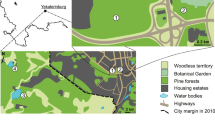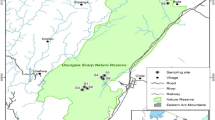Abstract
Responses of carabid beetles (Coleoptera: Carabidae) to urbanisation were studied along an urban-suburban-rural gradient representing decreasing intensities of humandisturbance. Carabids were collected by pitfall trapping during their activity period in lowland oak forest patches in the city of Debrecen, Eastern Hungary. The average number of carabid species was significantly higher in the rural and urban areas compared to the suburban one. The high overall species richness in the urban area was due to the presence of species preferring open habitats. The species richness of forest specialist carabids significantly increased along the urban-rural gradient. The overall carabid abundance was significantly higher in the rural than the other two areas. The results did not support the hypothesis that overall diversity should decrease in response to habitat disturbance. They also contradicted the intermediate disturbance hypothesis: species richness was not the highest in the moderately disturbed suburban area. In the urban area, opportunistic species dominated. The average carabid body size was significantly larger in the rural and suburban areas than in the more disturbed urban area. Multivariate methods detected changes in species composition and abundance structure along the urban-rural gradient. Significant proportion of the variation in abundance and species richness was explained by the heterogeneity of environmental variables (ground temperature, surface temperature, humidity, cover of decaying wood material, herbs, canopy layer, and by the amount of prey).
Similar content being viewed by others
References
Alaruikka D.M., Kotze D.J., Matveinen K. and Niemelä J. 2003. Carabid and spider assemblages along an urban to rural gradient in Southern Finland. Journal of Insect Conservation 6: 195–206.
Blake S., Foster G.N., Eyre M.D. and Luff M.L. 1994. Effects of habitat type and grassland management practices on the body size distribution of carabid beetles. Pedobiologia 38: 502–512.
Bryan K.M. and Wratten S.D. 1984. The responses of polyphagous predators to spatial heterogeneity: aggregation by carabid and staphylinid beetles to their cereal aphid prey. Ecological Entomology 9: 251–259.
Burke D. and Goulet H. 1998. Landscape and area effects on beetle assemblages in Ontario. Ecography 21: 472–479.
Butterfield J. 1997. Carabid community succession during forestry cycle in conifer plantations. Ecography 20: 614–625.
Connell J.H. 1978. Diversity in tropical rain forests and coral reefs. Science 199: 1302–1310.
Davies K.F. and Margules C.R. 1998. Effects of habitat fragmentation on carabid beetles: experimental evidence. Journal of Animal Ecology 67: 460–471.
Davis B.N.K. 1978. Urbanisation and the diversity of insects.. In: Mound L.A. and Waloff N. (eds), Diversity of Insect Faunas. Blackwell, London, UK, pp. 126–138.
Den Boer P.J. 1985. Fluctuations of density and survival of carabid populations. Oecologia 67: 322–330.
Desender K., Ervynck A. and Tack G. 1999. Beetle diversity and historical ecology of woodlands in Flanders. Belgian Journal of Zoology 129: 139–156.
Didham R.K., Ghazoul J., Stork N.E., Davis A.J. 1996. Insects in fragmented forests: a functional approach. Trends in Ecology and Evolution 11: 255–260.
Dofferêne M. and Legendre P. 1997. Species assemblages and indicator species: the need for a flexible asymmetrical approach. Ecological Monographs 67: 345–366.
Elek Z., Magura T. and Tóthmérész B. 2001. Impacts of non-native Norway spruce plantation on abundance and species richness of ground beetles (Coleoptera: Carabidae). Web Ecology 2: 32–37.
Eyre M.D. and Luff M.L. 2002. The use of ground beetles (Coleoptera: Carabidae) in conservation assessments of exposed riverine sediment habitats in Scotland and northern England. Journal of Insect Conservation 6: 25–38.
Fournier E. and Loreau M. 1999. Effects of newly planted hedges on ground-beetle diversity (Coleoptera, Carabidae) in an agricultural landscape. Ecography 22: 87–97.
Fournier E. and Loreau M. 2001. Respective roles of recent hedges and forest patch remnants in the maintenance of ground-beetle (Coleoptera: Carabidae) diversity in an agricultural landscape. Landscape Ecology 16: 17–32.
Gilbert O.L. 1989. The Ecology of Urban Habitats. Chapman and Hall, London, UK.
Godefroid S. and Koedam N. 2003. Distribution pattern of the flora in a peri-urban forest: an effect of the city-forest ecotone. Landscape and Urban Planning 54: 1–17.
Gray J.S. 1987 Species-abundance patterns. In: Gee J.H.R. and Giller P.S. (eds), Organization of Communities, Past and Present. Blackwell Scientific Publications, Oxford, UK, pp. 53–67.
Gray J.S. 1989. Effects of environmental stress on species rich assemblages. Biological Journal of the Linnean Society 37: 19–32.
Guillemain M., Loreau M. and Daufresne T. 1997. Relationships between the regional distribution of carabid beetles (Coleoptera: Carabidae) and the abundance of their potential prey. Acta Oecologica 18: 465–483.
Holliday N.J. 1991. Species responses of carabid beetles (Coleoptera, Carabidae) during postfire regeneration of boreal forest. The Canadian Entomologist 123: 1369–1389.
Hůrka K. 1996. Carabidae of the Czech and Slovak Republics. Kabourek, Zlin, Czech Republic.
Koivula M. 2002. Alternative harvesting methods and boreal carabid beetles (Coleoptera, Carabidae). Forest Ecology and Management 167: 103–121.
Koivula M., Punttila P. and Niemelä J. 1999. Leaf litter and the small-scale distribution of carabid beetles (Coleoptera, Carabidae) in the boreal forest. Ecography 22: 424–435.
Koivula M., Kukkonen J. and Niemelä J. 2002. Boreal carabidbeetle (Coleoptera: Carabidae) assemblages along the clear-cut originated succession gradient. Biodiversity and Conservation 11: 1269–1288.
Kutner M., Nachtschiem C., Wasserman W. and Neter J. 1996. Applied Linear Statistical Models. McGraw-Hill, Boston, Massachusetts, USA.
Legendre P. and Legendre L. 1998. Numerical Ecology. Elsevier Science, Amsterdam, The Netherlands.
Lövei G.L. 1984. Ground beetles (Coleoptera: Carabidae) in two types of maize fields in Hungary. Pedobiologia 26: 571–64.
Lövei G.L. and Sunderland K.D. 1996. Ecology and behavior of ground beetles (Coleoptera: Carabidae). Annual Review of Entomology 41: 231–256.
Mader H.J. 1984. Animal habitat isolation by roads and agricultural fields. Biological Conservation 29: 81–96.
Mader H.J., Schell C. and Kornacker P. 1990. Linear barriers to arthropod movements in the landscape. Biological Conservation 54: 209–222.
Magura T. 2002. Carabids and forest edge: spatial pattern and edge effect. Forest Ecology and Management 157: 23–37.
Magura T., Elek Z. and Tóthmérész B. 2002. Impacts of non-native spruce reforestation on ground beetles. European Journal of Soil Biology 38: 291–295.
Magura T., Ködöböcz V. and Tóthmérész B. 2001a. Effects of habitat fragmentation on carabids in forest patches. Journal of Biogeography 28: 129–138.
Magura T., Tóthmérész B. and Bordán Zs. 1997. Comparison of the carabid communities of a zonal oak-hornbeam forest and pine plantations. Acta Zoologica Academiae Scientiarum Hungaricae 43: 173–182.
Magura T., Tóthmérész B. and Bordán Zs. 2000a. Effects of nature management practice on carabid assemblages (Coleoptera: Carabidae) in a non-native plantation. Biological Conservation 93: 95–102.
Magura T., Tóthmérész B. and Elek Z. 2003. Diversity and composition of carabids during a forestry cycle. Biodiversity and Conservation 12: 73–85.
Magura T., Tóthmérész B. and Molnár T. 2000b. Spatial distribution of carabids along grass-forest transects. Acta Zoologica Academiae Scientiarum Hungaricae 46: 1–17.
Magura T., Tóthmérész B. and Molnár T. 2001b. Forest edge and diversity: carabids along forest-grassland transects. Biodiversity and Conservation 10: 287–300.
McDonnell M.J. and Pickett S.T.A. 1990. Ecosystem structure and function along urban-rural gradients: an unexploited opportunity for ecology. Ecology 71: 1232–1237.
McDonnell M.J., Pickett S.T.A., Groffman P., Bohlen P., Pouyat R.V., Zipperer W.C., Parmelee R.W., Carreiro M.M. and Medley K. 1997. Ecosystem processes along an urban-to-rural gradient. Urban Ecosystems 1: 21–36.
McIntyre N.E., Rango J., Fagan W.F., and Faeth S.H. 2001. Ground arthropod community structure in a heterogeneous urban environment. Landscape and Urban Planning 52: 257–274.
Naeem S., Thompson L.J., Lawler S.P., Lawton J.H. and Woodfin R.M. 1994. Declining biodiversity can alter the performance of ecosystems. Nature 368: 734–736.
Niemelä J. 1999. Ecology and urban planning. Biodiversity and Conservation 8: 119–131.
Niemelä J. and Spence J.R. 1994. Distribution of forest dwelling carabids (Coleoptera): spatial scale and the concept of communities. Ecography 17: 166–175.
Niemelä J., Kotze J., Ashworth A., Brandmayr P., Desender K., New T., Penev L., Samways M. and Spence J. 2000. The search for common anthropogenic impacts on biodiversity: a global network. Journal of Insect Conservation 4: 3–9.
Niemelä J., Kotze J.D., Venn S. Penev L., Stoyanov I., Spence J., Hartley D. and Montes de Oca E. 2002. Carabid beetle assemblages (Coleoptera, Carabidae) across urban-rural gradients: an international comparison. Landscape Ecology 17: 387–401.
Niemalä J., Haila Y., Halme E., Pajunen T. and Punttila P. 1992. Small-scale heterogeneity in the spatial distribution of carabid beetles in the southern Finnish taiga. Journal of Biogeography 19: 173–181.
Niemelä J., Spence J.R., Langor D., Haila Y. and Tukia H. 1994. Logging and boreal ground-beetle assemblages on two continents: implications for conservation.. In: Gaston K., Samways M. and New T (eds), Perspectives in Insect Conservation. Intercept Publications, Andover, UK, pp. 29–50.
Niemelä J., Haila Y. and Punttila P. 1996. The importance of small-scale heterogeneity in boreal forests: variation in diversity in forest-floor invertebrates across the succession gradient. Ecography 19: 352–368.
Pócs T. and Tóthmérész B. 1997. Foliicolous bryophyte diversity in tropical rainforests. Abstracta Botanica 21: 135–144.
Pouyat R.V., McDonnell M.J. and Pickett S.T.A. 1997. Litter decomposition and nitrogen mineralization in oak stands along an urban-rural land use gradient. Urban Ecosystems 1: 117–131.
Probst J.R. and Crow T.R. 1991. Integrating biological diversity and resource management. Journal of Forestry 89: 12–17.
Rainio J. and Niemelä J. 2003. Ground beetles (Coleoptera: Carabidae) as bioindicators. Biodiversity and Conservation 12: 489–506.
Scott W.A. and Anderson R. 2002. Temporal and spatial variation in carabid assemblages from the United Kingdom Environmental Change Network. Biological Conservation 110: 197–210.
Sergeeva T.K. 1994. Seasonal dynamics of interspecific trophic relations in a carabid beetle assemblage.. In: Desender K., Dufrêne M., Loreau M., Luff M.L. and Maelfait J.- P. (eds), Carabid Beetles: Ecology and Evolution. Kluwer Academic Publishers, Dordrecht, The Netherlands, pp. 367–370.
Sokal R.R. and Rohlf F.J. 1995. Biometry. Freeman, New York, New York, USA.
Spence J.R. and Niemelä J. 1994. Sampling carabid assemblages with pitfall traps: the madness and the method. The Canadian Entomologist 126: 881–894.
Spence J.R. and Spence D.H. 1988. Of ground beetles and men: introduced species and the synanthropic fauna of western Canada. Memoirs of the Entomological Society of Canada 144: 151–168.
Spence J.R., Langor D.W., Niemelä J., Cárcamo H.A. and Currie C.R. 1996. Northern forestry and carabids: the case for concern about old-growth species. Annales Zoologici Fennici 33: 173–184.
Stork N. 1990. The Role of Ground Beetles in Ecological and Environmental Studies. Intercept, Andover, UK.
Šustek Z. 1987. Changes in body size structure of carabid communities (Coleoptera, Carabidae) along an urbanisation gradient. Biológia (Bratislava) 42: 145–156.
Thiele H.U. 1977. Carabid Beetles in Their Environments. Springer, New York, New York, USA.
Tonteri T. and Haila Y. 1990. Plants in a boreal city: ecological characteristics of vegetation in Helsinki and its surroundings, southern Finland. Annales Botanici Fennici 27: 337–352.
Vida G. 1978. Genetic diversity and environmental future. Environmental Conservation 5: 127–132.
Wootton J.T. 1998. Effects of disturbance on species diversity: a multitrophic perspective. The American Naturalist 152: 803–825.
Author information
Authors and Affiliations
Corresponding author
Rights and permissions
About this article
Cite this article
Magura, T., Tóthmérész, B. & Molnár, T. Changes in carabid beetle assemblages along an urbanisation gradient in the city of Debrecen, Hungary. Landscape Ecol 19, 747–759 (2004). https://doi.org/10.1007/s10980-005-1128-4
Received:
Accepted:
Issue Date:
DOI: https://doi.org/10.1007/s10980-005-1128-4




